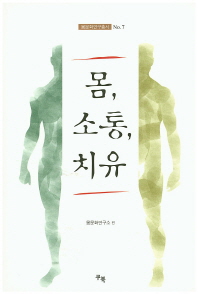- 글번호
- 910357
Body, Communication, Healing
- Writer
- 몸문화연구소
- View
- 66
- Date
- 2018.06.01
- 수정일
- 2024.04.03


Series Book - Body, Communication, Healing
Without our bodies, we cannot act nor express and communicate thoughts and feelings.
Even if you don't open your mouth, your body is constantly expressing something like a scent.
Thus the book, Body, Communication, Healing, attempts to see what the body actually is from
the perspective of e-x-p-r-e-s-s-i-o-n, communication and healing.
Through its 9 chapters, the book examines the process by which the body becomes meaning as
symptoms and healing, and how such ‘meaning’ becomes our actions. In Chapter 1, in order to
prepare for the future content, we first approach the question “what is a body?” and then try to
unify the terms related to 'body'. Chapter 2, outlines Maurice Blondel's "philosophy of action",
dealing with the function and meaning of the body. In Chapter 3, we focus on the current social s
tatus where the number of people who want to express themselves in the present era has soared
beyond that of the viewers. Chapter 4 argues that a new mode of subjectification will come true
once the face of the patriarchy, strengthening ‘the father's order’, is eradicated. Chapter 5 examines
both the traditional and modern theory of justice with each finally presenting an ‘aesthetic theory’
as their alternative. Next in chapter 6, by looking into Frida Kahlo's life and works, the book claims
that it is possible to cure 'the alienation of the other' by ‘overcoming symptoms through symptoms’.
In Chapter 7, based on the discussion that our human gestures are vessels that reveal the mind,
while in turn the ‘fluctuations’ made inside them again become the gestures, the text further argues
that it is possible to analyze the state of mind and body through the rhythms such fluctuations have.
Chapter 8 examines the poetic process of ethical subject composition by looking at the “sick bodies”
that appear in Oh's poems. Lastly, Chapter 9 draws on the science fiction work, She (2014), to emphasize
that humans must also learn to love machines.
Without our bodies, we cannot act nor express and communicate thoughts and feelings.
Even if you don't open your mouth, your body is constantly expressing something like a scent.
Thus the book, Body, Communication, Healing, attempts to see what the body actually is from
the perspective of e-x-p-r-e-s-s-i-o-n, communication and healing.
Through its 9 chapters, the book examines the process by which the body becomes meaning as
symptoms and healing, and how such ‘meaning’ becomes our actions. In Chapter 1, in order to
prepare for the future content, we first approach the question “what is a body?” and then try to
unify the terms related to 'body'. Chapter 2, outlines Maurice Blondel's "philosophy of action",
dealing with the function and meaning of the body. In Chapter 3, we focus on the current social s
tatus where the number of people who want to express themselves in the present era has soared
beyond that of the viewers. Chapter 4 argues that a new mode of subjectification will come true
once the face of the patriarchy, strengthening ‘the father's order’, is eradicated. Chapter 5 examines
both the traditional and modern theory of justice with each finally presenting an ‘aesthetic theory’
as their alternative. Next in chapter 6, by looking into Frida Kahlo's life and works, the book claims
that it is possible to cure 'the alienation of the other' by ‘overcoming symptoms through symptoms’.
In Chapter 7, based on the discussion that our human gestures are vessels that reveal the mind,
while in turn the ‘fluctuations’ made inside them again become the gestures, the text further argues
that it is possible to analyze the state of mind and body through the rhythms such fluctuations have.
Chapter 8 examines the poetic process of ethical subject composition by looking at the “sick bodies”
that appear in Oh's poems. Lastly, Chapter 9 draws on the science fiction work, She (2014), to emphasize
that humans must also learn to love machines.